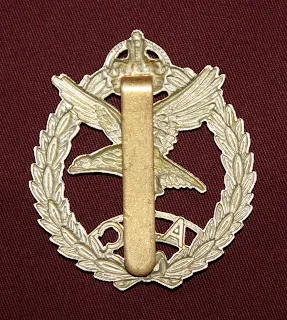A query by a gentleman named Frank from the Netherlands has prompted the subject of this article. Unfortunately, the World War II British Army Air Corps cap badge has been the target of counterfeiters almost as frequently as the Parachute Regiment cap badge. The Army Air Corps was formed in February of 1942, and was comprised of the Glider Pilot Regiment (GPR) and the Parachute Regiment, both wearing the same cap badge until the Parachute Regiment received its own in May of 1943. Following that date, the badge was only worn by the Glider Pilot Regiment through to the conclusion of WWII. Technically as of April of 1944, the Special Air Service (SAS) was attached to the Corps, but continued to wear their then well-established winged dagger cap badge.
The basic badge is of white metal, and comprised of a circular laurel wreath with a right facing eagle superimposed and clutching two semi-circular bars attached at the base of the wreath containing the plain (no serifs) three block letters, A.A.C At the top is the standard imperial King’s Crown (K.C.). It was conventionally die-struck with lugs. There is a continuing controversy as to a genuine variant using a slider.
The author was presented with a slider variant in white metal by a retired major, who had served in the GPR during the latter stages of WWII, with an accompanying letter specifically stating in part, “Enclosed is a Glider Pilot Regiment cap badge. It is a genuine wartime one, not a later re-strike.” It was not his personal badge but a standard one issued to other ranks. It features include (double click to enlarge images);
- A slider not lugs
- A slightly blunted, not pointedly sharp eagle’s beak
- A voided K.C. with well defined detail
- Clean reverse die strike
- Sharp well-defined tips on laurel wreath leaves
- Non-voided letters in “A.A.C”, two periods very well defined
- Clean definition of letters from bars
- Laurel leaf barely touching, not overlapping third feather from bottom of right (left as viewed from front) wing
- Extremely well-defined legs and claws (talons)
As inferred from above the following badge features should be carefully inspected;
Lugs not slider preferred unless additional provenance available
Definition of eagle’s beak and claws(talons), in this case the flawed (blunted) eagle’s head and beak indicates higher probability of genuine badge. Also note flaw in tip of laurel leaf.
Laurel wreath leaves on left side extending over eagle’s wing feathers
Non-Voided letters (A.A.C) versus Voided (non-voided preferred)
Well defined cross on top of crown
Clean, well defined die strike particularly as viewed from reverse of badge
Sharp leave tips on laurel wreath
In addition to the basic badge the following legitimate variants are known to exist. Starting with the basic white metal badge issued to other ranks I will hopefully show in sequence an image of a genuine example of each (front, and reverse when available).
Basic badge, die struck in white metal
Die cast, not struck, in gilding metal with 3 lugs
Solid silver, hallmarked with three lugs (Officer’s)
Cast bronze (allegedly genuine with rather crude casting of eagle’s head, sharp beak, and 3 lugs, also note overall crude lack of definition)
Economy issue in bakalite
Silver embroidered bullion wire on maroon backing (Officers)
The metallurgy of white metal is (64,5% Copper, 16,5% Zinc, 19,0% Nickel by weight, Royal Army Clothing Department Pattern No. 4481/1897) with brass lugs.Gilding metal is very similar (86,7% Copper, 13,3% Zinc), with brass being (67% Copper and 33% Zinc).















4 comments:
Please could you let me know how to contact you. I have some glider pilot regiment photos you may be interested in. I tried to email them from the contact on your blog but it came back undelivered. Thanks
Hello Unknown,
Thank you very much for your interest. If you already are, or after jointing (a simple process)The British and Commonwealth Military Badge Collectors Forum, you can send a private message to Arnhem Jim or Arnhemjim. If you have any difficulty in attaching images, please let me know via private message, and I can give you another e-mail address. Apologies for any inconvenience, but with all the privacy issues occurring on the Internet, think that would be safer for both of us. Once again sincere thanks.
Best regards,
Jim
Thank you Jim. I have sent you a message on the forum altho am unable to attach the photos.
Kind regards
Gema
Hello Gema,
Have sent you a reply with information on the forum with which you should be able to transmit the photos. My sincere thanks for imposing the additional effort on you. Am certainly most appreciative, and am looking forward to receiving the images. If you haven't seen it already, you may find the newest article on the blog of some interest as it relates to the Glider Pilot Regiment.
Best regards,
Jim
Post a Comment